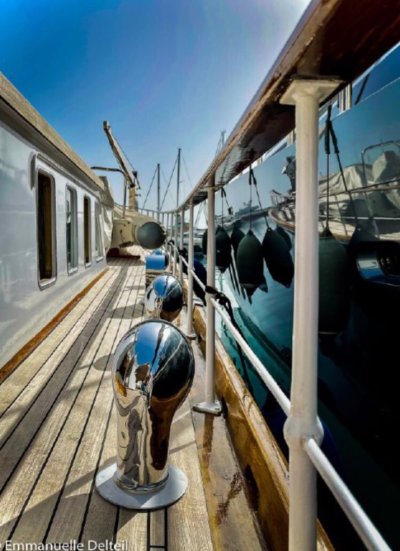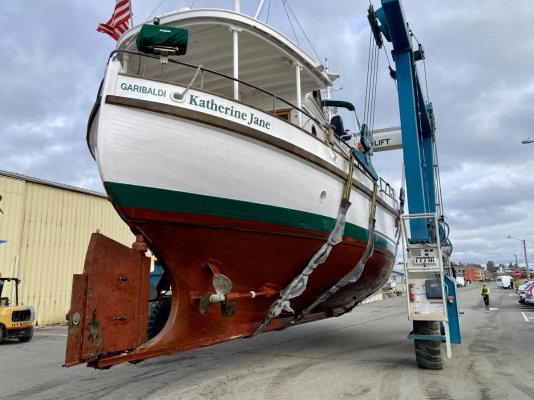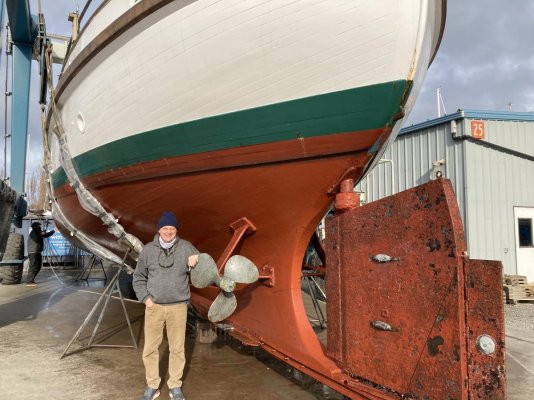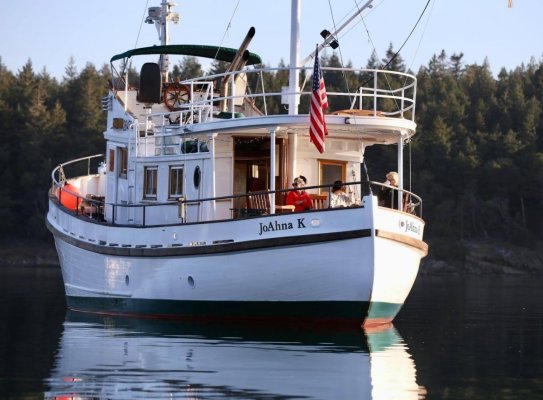You are using an out of date browser. It may not display this or other websites correctly.
You should upgrade or use an alternative browser.
You should upgrade or use an alternative browser.
Interesting boats
- Thread starter Steve
- Start date
The friendliest place on the web for anyone who enjoys boating.
If you have answers, please help by responding to the unanswered posts.
If you have answers, please help by responding to the unanswered posts.
MurrayM
Guru
Quite sure she’s a motor sailer.
Nice hull. No fwd visibility.
CQR anchor usually indicates a sailboat owner.
Good call. Zooming in on the photo, it looks like there might be a mast step sort of affair in front of the pilothouse windows.
klee wyck
Guru
- Joined
- Feb 8, 2014
- Messages
- 1,025
- Location
- USA PNW
- Vessel Name
- Domino and Libra
- Vessel Make
- Malcom Tennant 20M and Noordzee Kotter 52
Interesting! Would love to see interior pics and his cruising style/history
Jack,(Steve)
That is a little runabout around 20’ with little or no accommodations.
It can scoot though.
He passed me in Bellingham Bay the other day doing Mach III and then I was tied up next to him at the Seaview dock.
I am guessing Bellingham to Eastsound for him is thirty minutes!
Alaskaflyer
Guru
https://www.yachtworld.com/boats/1959/custom-classic-motoryacht-3824178/

Edit: ah, I see they're auctioning her with a low starting bid now, 50k euro.
Edit: ah, I see they're auctioning her with a low starting bid now, 50k euro.
Attachments
Last edited:
OldDan1943
Guru
- Joined
- Oct 2, 2017
- Messages
- 10,656
- Location
- USA
- Vessel Name
- Kinja
- Vessel Make
- American Tug 34 #116 2008
WOOD hull, teak decks
Lots of room for the crew.
I do hope the next owner has many happy hours cruising and continues to have it professional maintained.
Lots of room for the crew.
I do hope the next owner has many happy hours cruising and continues to have it professional maintained.
Hippocampus
Guru
- Joined
- Jul 27, 2020
- Messages
- 4,182
- Location
- Plymouth
- Vessel Name
- Hippocampus
- Vessel Make
- Nordic Tug 42
May be the rest of the box is under the deck with drainage off the side of the hull. Couldn’t access the full listing and rest of the pics.
Have seen that. Cowlings removed and cover plate screwed in before getting underway so nice walk ways. Put back at anchor to allow good ventilation when at anchor.
Never seen it on a power boat though.
Have seen that. Cowlings removed and cover plate screwed in before getting underway so nice walk ways. Put back at anchor to allow good ventilation when at anchor.
Never seen it on a power boat though.
Last edited:
rslifkin
Guru
- Joined
- Aug 20, 2019
- Messages
- 8,005
- Location
- Rochester, NY
- Vessel Name
- Hour Glass
- Vessel Make
- Chris Craft 381 Catalina
May be the rest of the box is under the deck with drainage off the side of the hull.
Definitely possible. I keep debating building internal dorade boxes like that for my stupidly placed engine room vents.
OldDan1943
Guru
- Joined
- Oct 2, 2017
- Messages
- 10,656
- Location
- USA
- Vessel Name
- Kinja
- Vessel Make
- American Tug 34 #116 2008
When I had a galley hood and fan installed, I had a dorade box made for the outside vent even thought it vents to the upper deck, if for no other reason than to keep the rain out. SMILE Now, instead of the dorade vent, I really should install a pipe taller than the pilot house roof and install a multi-directional vent. I will let the next owner worry about that.
socalrider
Guru
- Joined
- Feb 14, 2020
- Messages
- 1,061
- Location
- usa
- Vessel Name
- SEA WOLF
- Vessel Make
- 1979 CHB 41 Trawler
This is an interesting hull, no? Full displacement double ender but with a chine. Two props but one rudder. Looks beautiful - hope they add some interior shots.
https://www.yachtworld.com/boats/1982/knight-carver-expedition-3832974/
https://www.yachtworld.com/boats/1982/knight-carver-expedition-3832974/
"Huge rudder. Imagine when the more that large plate is swung considerably to one side or the other that prop wash might at least somewhat work for turning the boat. Higher rpm probably makes for more turning wash. Lower rpm not so much; but, at idle with twins and thruster maneuvering should still be relatively easy. I would not like to handle that boat with single center rudder and out side props in a dangerous following sea. And... 5 blade props??? prop efficiency decreases per number of blades. Wonder if the turn-handling problems has owner try different props in search of best combo of outside duals for single center rudder?"
We have a friend with the same setup, twins on a single rudder. He can put that boat where guys like me with twins and twin rudders fear to go. He admitted to a learning curve when the boat was new to him, but very quickly overcame it. That was before he put in a bow thruster. Now there is nothing that discourages him.
We have a friend with the same setup, twins on a single rudder. He can put that boat where guys like me with twins and twin rudders fear to go. He admitted to a learning curve when the boat was new to him, but very quickly overcame it. That was before he put in a bow thruster. Now there is nothing that discourages him.
Last edited by a moderator:
RT Firefly
Enigma

trawlercap
Senior Member
- Joined
- Aug 24, 2020
- Messages
- 296
- Location
- USA
- Vessel Name
- JoAhna K
- Vessel Make
- 58' Bill Garden Trawler 1952
OldDan1943
Guru
- Joined
- Oct 2, 2017
- Messages
- 10,656
- Location
- USA
- Vessel Name
- Kinja
- Vessel Make
- American Tug 34 #116 2008
Beautiful boat!!!
If I had a 58ft boat, I could empty my storeroom and devote a closet to my sweetie.
If I had a 58ft boat, I could empty my storeroom and devote a closet to my sweetie.
58’ William Garden, built 1952. Single articulating fishtail rudder, twin Lugger’s 165hp each, 30” wheels. Steadiest on track boat I ever steered. Quiet, no fuss, slippery View attachment 117563
View attachment 117564
View attachment 117565
t c - Your boat has my heart!
In regard to your many experiences... How does she track in slow forward
speed, respond in reverse and handle during following seas? The first two I'm confident are muchly taken care of by alternating propeller propulsion directions and rpm. The third I believe would be somewhat automatically accommodated due to her slicing stern design. However, if a breach were to begin... that enormous articulating rudder do the trick of straightening her back up?
I respectfully ask these questions simply because I've never handled a design such as yours with twins to the sides and rudder in center. She is beautiful and was born same year as me!
Last edited:
rslifkin
Guru
- Joined
- Aug 20, 2019
- Messages
- 8,005
- Location
- Rochester, NY
- Vessel Name
- Hour Glass
- Vessel Make
- Chris Craft 381 Catalina
t c - Your boat has my heart!
In regard to your many experiences... How does she track in slow forward
speed, respond in reverse and handle during following seas? The first two I'm confident are muchly taken care of by alternating propeller propulsion directions and rpm. The third I believe would be somewhat automatically accommodated due to her slicing stern design. However, if a breach were to begin... that enormous articulating rudder do the trick of straightening her back up?
I respectfully ask these questions simply because I've never handled a design such as yours with twins to the sides and rudder in center. She is beautiful and was born same year as me!
That rudder is big enough that the limited prop wash over it shouldn't be much of an issue handling wise. And if turned far enough, it'll defect some wash from one of the props anyway.
trawlercap
Senior Member
- Joined
- Aug 24, 2020
- Messages
- 296
- Location
- USA
- Vessel Name
- JoAhna K
- Vessel Make
- 58' Bill Garden Trawler 1952
Going strait, 8-9 knots, the auto pilot adjusts in very small amounts. I suspect a one degree rudder angle is accentuated by the tail flap: video of the rudder in action.'cap, how effective is the articulated rudder tab?
https://youtube.com/playlist?list=PL-pHCNJheWfSyHM_AU278Sdu13nwzIKbA
trawlercap
Senior Member
- Joined
- Aug 24, 2020
- Messages
- 296
- Location
- USA
- Vessel Name
- JoAhna K
- Vessel Make
- 58' Bill Garden Trawler 1952
UOTE=Art;1003073]t c - Your boat has my heart!
In regard to your many experiences... How does she track in slow forward
speed, respond in reverse and handle during following seas?at 61 tons I idle in neutral a lot in close quarters and she responds just fine down to a knot. I want to add a jog stick, hyd. A with power assist idling a big wheel is more work than fun. Reverse? No boat steers in reverse, using strait rudder and props I get around fine in reverse. Following seas I have yet to enjoy, I have reports it tracks like a train m The first two I'm confident are muchly taken care of by alternating propeller propulsion directions and rpm. The third I believe would be somewhat automatically accommodated due to her slicing stern design. However, if a breach were to begin... that enormous articulating rudder do the trick of straightening her back up?
I respectfully ask these questions simply because I've never handled a design such as yours with twins to the sides and rudder in center. She is beautiful and was born same year as me![/QUOTE]
In regard to your many experiences... How does she track in slow forward
speed, respond in reverse and handle during following seas?at 61 tons I idle in neutral a lot in close quarters and she responds just fine down to a knot. I want to add a jog stick, hyd. A with power assist idling a big wheel is more work than fun. Reverse? No boat steers in reverse, using strait rudder and props I get around fine in reverse. Following seas I have yet to enjoy, I have reports it tracks like a train m The first two I'm confident are muchly taken care of by alternating propeller propulsion directions and rpm. The third I believe would be somewhat automatically accommodated due to her slicing stern design. However, if a breach were to begin... that enormous articulating rudder do the trick of straightening her back up?
I respectfully ask these questions simply because I've never handled a design such as yours with twins to the sides and rudder in center. She is beautiful and was born same year as me![/QUOTE]
Last edited:
rslifkin
Guru
- Joined
- Aug 20, 2019
- Messages
- 8,005
- Location
- Rochester, NY
- Vessel Name
- Hour Glass
- Vessel Make
- Chris Craft 381 Catalina
Twins with plenty of prop walk steer just fine in reverse. Just have to get used to ignoring the rudder(s). Leave them centered and only steer with the engines. If you want to turn, take one engine out of gear and you'll turn that direction. To turn tighter, give a kick of forward thrust on that engine and the turn will tighten.
trawlercap
Senior Member
- Joined
- Aug 24, 2020
- Messages
- 296
- Location
- USA
- Vessel Name
- JoAhna K
- Vessel Make
- 58' Bill Garden Trawler 1952
Twins with plenty of prop walk steer just fine in reverse. Just have to get used to ignoring the rudder(s). Leave them centered and only steer with the engines. If you want to turn, take one engine out of gear and you'll turn that direction. To turn tighter, give a kick of forward thrust on that engine and the turn will tighten.
That’s it right there. Just start backward and see what she wants, adjust direction with props while you continue backing��
Going strait, 8-9 knots, the auto pilot adjusts in very small amounts. I suspect a one degree rudder angle is accentuated by the tail flap: video of the rudder in action.
https://youtube.com/playlist?list=PL-pHCNJheWfSyHM_AU278Sdu13nwzIKbA
t c - Thanks! I see how rudder articulation mechanism works... cool! I bet that well assists for propwash to throw beam of water helping to turn boat.
I imagine so the hinge and slide bar don't get gummed up by sea growth that fairly often the rudder should be thrown full over to each side. That's a use it or loose it situation...
Last edited:
C lectric
Guru
++++++++However, if a breach were to begin... that enormous articulating rudder do the trick of straightening her back up?+++++++++
It will if you are on the ball. When in a following rough sea and the boat does not want to straighten up even with full wheel then a STRONG shot of engine power will push a BEEG stream of water past the rudder. Use it.
I am not talking about enough throttle to pick up a bunch of speed, but a quick strong shot of throttle and then back off to your normal revs.
My boat is quite different, a lot smaller, with essentially a planing hull and a flat transom so I do get pushed. Yours should not get pushed to that degree but if you feel the boat not responding use that throttle.
It will if you are on the ball. When in a following rough sea and the boat does not want to straighten up even with full wheel then a STRONG shot of engine power will push a BEEG stream of water past the rudder. Use it.
I am not talking about enough throttle to pick up a bunch of speed, but a quick strong shot of throttle and then back off to your normal revs.
My boat is quite different, a lot smaller, with essentially a planing hull and a flat transom so I do get pushed. Yours should not get pushed to that degree but if you feel the boat not responding use that throttle.
trawlercap
Senior Member
- Joined
- Aug 24, 2020
- Messages
- 296
- Location
- USA
- Vessel Name
- JoAhna K
- Vessel Make
- 58' Bill Garden Trawler 1952
Yes, tolerance are loose probably for that reason, with no prop in front of this rudder, propwash does not effect steering. It actually one of the factors in the boat cruising so smooth, no turbulent water over the rudder ( no vibration)t c - Thanks! I see how rudder articulation mechanism works... cool! I bet that well assists for propwash to throw beam of water helping to turn boat.
I imagine so the hinge and slide bar don't get gummed up by sea growth that fairly often the rudder should be thrown full over to each side. That's a use it or loose it situation...
trawlercap
Senior Member
- Joined
- Aug 24, 2020
- Messages
- 296
- Location
- USA
- Vessel Name
- JoAhna K
- Vessel Make
- 58' Bill Garden Trawler 1952
++++++++However, if a breach were to begin... that enormous articulating rudder do the trick of straightening her back up?+++++++++
It will if you are on the ball. When in a following rough sea and the boat does not want to straighten up even with full wheel then a STRONG shot of engine power will push a BEEG stream of water past the rudder. Use it.
I am not talking about enough throttle to pick up a bunch of speed, but a quick strong shot of throttle and then back off to your normal revs.
My boat is quite different, a lot smaller, with essentially a planing hull and a flat transom so I do get pushed. Yours should not get pushed to that degree but if you feel the boat not responding use that throttle.
So many factors effect a boats behavior. If your vessel is overwhelmed from behind you will have to rely on my things you can’t control. Center of boyancy, center of gravity, bow shape and weight, if she’s balanced or not on the ends etc. angle of the overtaking seas,your speed, on and on. If she’s cranky and unstable by design, you neeed throttle and steering tricks. But those efforts are not as critical as the built in features. Down swell is the least stable course.
Last edited:
Nomad Willy
Guru
I can steer my Willard when backing from about 1.5 to 2.4 knots. But I can accurately steer the boat.
Last edited:
trawlercap
Senior Member
- Joined
- Aug 24, 2020
- Messages
- 296
- Location
- USA
- Vessel Name
- JoAhna K
- Vessel Make
- 58' Bill Garden Trawler 1952
That’s the sweet balance shape giving you great performance.I can steer my Willard when backing from about 1.5 to 2.4 knots. Need to hold on tight to insure the rudder dos’nt flop over. That could cause some damage. But I can accurately steer the boat.
rslifkin
Guru
- Joined
- Aug 20, 2019
- Messages
- 8,005
- Location
- Rochester, NY
- Vessel Name
- Hour Glass
- Vessel Make
- Chris Craft 381 Catalina
Down swell is the least stable course.
Only for a slow boat. Once you can outrun the waves, down wind changes from unstable to a fast and fun rocket ride. In 4 footers, down wind is the fastest and most comfortable direction to run for my boat. Just set engines to max continuous and start a cycle of slow down and climb, pitch over, accelerate / surf, repeat. All in good comfort and with just a light touch on the wheel.
Similar threads
- Replies
- 3
- Views
- 1K






